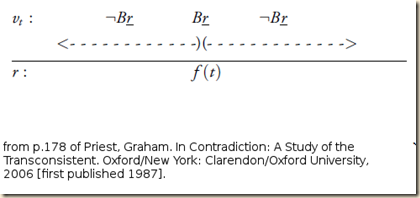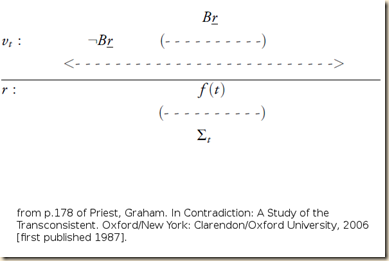[Search Blog Here. Index-tags are found on the bottom of the left column.]
[Central Entry Directory]
[Logic & Semantics, Entry Directory]
I came across the following video (through Deleuze scholar Rockwell Clancy’s facebook feed). If you have not seen it, I think you might be amazed for reasons that could be further examined. [Best seen on youtube: http://www.youtube.com/watch?v=FTByHbjgz8k#t=27]
The following is highly experimental and is meant to serve as the starting mistakes for a larger project currently under development.
This project examines Gilles Deleuze’s ‘Logics’. We have two “logic” books by Deleuze, Francis Bacon: The Logic of Sensation and The Logic of Sense. I believe that Deleuze’s Cinema 1 and 2 comprise a third logic book, what we might title The Logic of Signs. All three ‘logics’ share the common logic of affirmative synthetic disjunction [I discuss this further pp.204-205 of "In the Still of the Moment"]. Informally, in Deleuze’s logic, incompatible states of affairs are given as forced together. There are 'tensions' between them on account of their contrariety. More formally speaking, say that term B is not term A. Now note that when A is conjoined with not-A, we have a contradiction. But there is no ‘sense’ or meaning resulting when A and A are conjoined self-redundantly. However, there is significance when information is non-redundant with itself, and thus introduces contradictory combinations. We find in the world both A and B at once (in contradictory states of affairs between one instant and the next, for example) which means we find A and not-A in combination. We have a contradiction that is real, true and meaningful [and such a logic of contradiction is useful for accounting for change and becoming]. I mean meaningful in a number of ways:
Synthesis of Contradictory Structures
[What are the basic structures that make relations sensible?]
Prelinguistic, signalitic meaning [in the sense of pre-linguistic signs. See Deleuze Cinema 2, chapter 2. For this, we examine structures that create the pathways or tendencies by which specific terms will relate in meaningful ways].
There are basic structures that relate series of terms under certain modes of conjunction. For example, Deleuze shows how perceived variations of depth in film can be conjoined with variations of time in the story. The co-presence of different spatial points then implicitly suggests the contradictory co-presence of temporally distinct moments of time. More specifically, the temporal relations ‘before’ and ‘after’ are given in depth of field shots. Let's look quickly at some relevant scenes in Orson Welles' Citizen Kane. The film is largely composed of flashbacks from people who knew Kane. In one case it is his second wife, who enjoyed singing but never aspired to be a professional, and she was never gifted enough to be one in the first place. When she is being interviewed about Kane's past, the camera as you can see in the clip below starts from high and seemingly moves down onto the wife, as if we are falling through the depths of time by probing into her memories of the distant past.
Before drawing any inferences about what we see, and before the sense data can come into any additional relations, we first notice a basic structural feature in the video. There is often a lot of visual depth in the original video, now forming a background to the flat plane inserted on its surface. The new frame is sized and composed so to appear as though it occupies one of the levels of depth in the broader image, looking like a movie screen standing up some distance into the field of visual depth of the scene.
There are even instances where he inserts his image onto mirrors to replicate a reflection.
The basic content of the overlaid image is often made so that it seems to extend past its boundaries into the background.
Here are some notable moments where the actions in the box are coordinated with the extremities of Spears' motions.
There is also a scene where he is made to seem as though his two-dimensional image moves through the three-dimensionality of the background. I include it with the original for comparison.
There is also a scene where he adjusts the color of the inner frame to match the background.
There also seem to be shots that would be too problematic to replicate, perhaps because of a difficult high angle. In these cases and in some others, he places a red dot over top of Spears. But to make that technique more seamless, he at times puts a red dot over his own face, perhaps only to equalize the instances.
However, despite these efforts to maintain the junction of the two series of moving images, there is still a strong tension between them. No matter how matched the images are, it still appears as though the overlaid image is two-dimensional and its surroundings three-dimensional. In some cases the match is noticeably off (perhaps intentionally), and in other cases the inserted image extends outside the frame of the background, reinforcing its two-dimensional overlaid look.
So while our eyes are forced to place the two series of images together, they are strongly incompatible. They are a cross-over of two different worlds, a two-dimensional one and a three-dimensional one. This is the basic structural feature that will create the basis for how the two series of terms relate differentially and meaningfully. In other words, this structure combines distinct series from separate domains, and by forcing them together, provides the conditions for the sensibility of their differential relations.
[How do the structures of relation bring together contradictory sense-data in an informative way?]
Affective meaning: Significant sense data. Our five senses provide us with data about the world around us (and within us). Yet, we do not find meaning in redundancies in sense information. In fact, our nervous systems 'desensitize' themselves to constancies of sensation [see Marieb and Hoehn, Bateson, and Bergson]. We are more sensitive it seems to differences and incompatibilities in sense data when the information does not ‘compute’ and calls for our closer attention. Consider being in a warm room during a cold winter day. After a while, we get cozy, and we begin to sense things other than the room's temperature. But when we go outside into the frigid cold, we are instantly very aware of the change in temperature. It is a difference that makes a difference. It tells us to change our behavior, to cover our exposed skin and hurry to our destination. So affective meaning is sense data that ‘tells’ us something even before we consciously interpret it. And the data here are not just for example the warmth of the room and the cold of the outside air; rather, the experience of the difference between them is itself the significant datum, the difference that makes a difference. [See this entry for more on Bateson's definition of information as 'difference that makes a difference.']
To analyze how the structural features of the image bring about contradictory sensations, let's take an example from Deleuze's Logic of Sensation, the painting Figure at a Washbasin, 1976 by Francis Bacon.
Often times in Bacon's paintings, there is a shape enclosing a figure. This is a structural feature that organizes the 'forces' in the painting. In some cases, the forces are acting dually against one another, and in certain instances they might give the impression of interchanging in-and-out flows. In this painting, the circle may seem to be closing in on the body, squeezing it. But the figure then pushes outward on the circle, as it seems to be flexing as though resisting and pushing back on that pressure. And also, he seems to be evacuating and escaping the confines of the circle through the drain.
The structural feature of the painting, the enclosing circle, combines incompatible forces, namely those pressing in and those pressing out. These forces intersect and collide in the figure's body, making it shake and spasm. We have the sensation then of a motion over and above the simpler two. We have two unidiretional motions, and the third non-directional vibrational motion which is a disjunctive synthesis of the other two. [For more on Deleuze's analysis of the diastole/systole rhythm in this painting, look toward the end of this entry.]
In the music video, we are also given this impression of a back-and-forth dance between the overlaid frame and the background. The box at some times tightens around the inserted dancer, while at other times he seems to push the boundaries outward. We do not get the impression of spasms in the video like we do in the painting. What we have instead it seems is a more erotic play of encroachment and retreat, and this comes not from the content of either series but in the interaction between them. Here are some instances where we see the box's boundaries in motion.
[We draw inferences from the given data. How do contradictions between series of inferences themselves have inferential value?]
Dramatic/literary/explanatory meaning. [Warning: this portion is problematic and vague.] A story is a series of rabbits out of hats, by which I mean, the events unfold without scientific predictability. If we could deduce the whole tale all the way down to its conclusion only from first hearing the beginning lines, then we would not need to follow along with it. Narrative events in a way are meaningfully connected but not logically implicit in one another. The tension between one trend in a story and a new divergent line beginning after a sudden twist has dramatic power to it. Consider an Aesop fable, 'The Fox and the Grapes':
A hungry Fox saw some fine bunches of Grapes hanging from a vine that was trained along a high trellis, and did his best to reach them by jumping as high as he could into the air. But it was all in vain, for they were just out of reach: so he gave up trying, and walked away with an air of dignity and unconcern, remarking, "I thought those Grapes were ripe, but I see now they are quite sour." [from Project Gutenberg]
Perhaps one way we mentally obtain explanations is by finding significance in differences between series of inferences in the story. In our example, we seem to have two pairings of inferences, with one set preceding the fox's change of mind, and another following that shift.
Inference series A:
The grapes are desirable.
The fox is determined to eat them.
Inference series B:
The grapes are not desirable.
The fox is not so determined to eat them.
The difference and tensions between these series make sense if we add the dramatic moment. There is an aleatory point, a moment of uncertainty when the meanings shift [for more on narrative bifurcation, see pp.211-218 of "Still of the Moment"]. We might even say it is a moment of self-forgery [see this entry on the topic of self-development and the power of falsity]. The fox pretends to be the same self, but really he has changed, going from a determined creature to a less ambitious one. But he externalizes this change by revising the inferences of his world though his modifying the value of the grapes.
Sadly I do not have a stronger methodology than this, but let's still experiment with it in the video. The main idea again is to look for inferential series and more importantly the contradictions between them, and asking what is the added significance of those contradictions.
[The warning continues to apply in the following.] Here we do not have a linear story. But we do have the inferred information from two series, that from in the box and that from outside it. We sometimes catch brief glimpses of Spears' obscured erotic body-presentation and movements. The background dancers reflect that, even when she is hidden. We can tell she has a slender and curved body. We might be led to draw certain inferences from this about female sexuality, for example, that it can be expressed by moving in a certain seductive way and by having a particular body-shape. Yet, even within the visible box the male dancer makes motions, gestures, and facial expressions that seem still somehow entirely fitting with this conventional view of feminine sexuality. In fact, we might even find his performance even more passionate in that regard. Here are some comparisons of particular expressions. You might find that Spears' movements seem more forced and mechanical.
So in the overlaid video, there is a tension between the series. Series A (of the background) leads to the inferences the main dancer is a slender woman moving seductively. Series B (of the overlaid foreground) makes us directly infer that the central figure is a large man also moving seductively. There is a series of tensions between the unfolding of these inferences, and the series combine all while strongly insisting on their incompatibility and contrariety. That tension could lead to inferences not found within either series, for example, possibly that there is no strong basis to distinguish male and female sexuality in the way that music videos might normally suggest, and it also might call into question the normal standards for the sexuality of women's appearance and self-presentation. The video is sexier with the large man, because he expresses eroticism more effectively with his more natural movements and facial expressions. This may not be the most interesting way to interpret the differential tensions between the two series of inferences. I chose it because it seemed the most obvious.
Works cited and presented:
Gal Volinez. [Volinez Spears] "HI Brit"
http://www.youtube.com/watch?v=FTByHbjgz8k
Britney Spears. "Work Bitch"
[BritneyspearsVEVO]
http://www.youtube.com/watch?v=pt8VYOfr8To





.jpeg)

























































